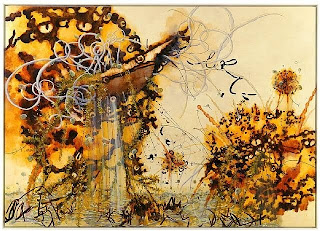Artwork by Rosemarie Fiore (compared to Tlaotlon)
My next Dummy essay is up, '"Messy"' Techno and the Resurgence of Musical Abstraction" (click here), a 'look at the current wave of quasi-techno artists, from Ital to Actress, who are united in their abstract approach and pure sonic sensuality. Featuring Actress, Laurel Halo, Ital, Tlaotlon, AyGeeTee, Lee Gamble, Pete Swanson, Bee Mask and Gobby.
Artwork by Joanne Greenbaum (compared to Lee Gamble)
Sporadically, over the past few years, artists from several surprisingly distinct corners of pop music’s underground have been converging on a particular method: a messy, rough-edged, restless churn of sonic material that’s often associated with techno, but only suggests that genre the way a pile of twisted metal, ash and melted plastic suggests some kind of joyridden and abandoned vehicle...
Artwork by Fabian Marcaccio (Compared to Pete Swanson)
Classic techno is, or was, futuristic in a very late-twentieth-century way – sleek, shimmering, robotic in the Kraftwerkian sense, metronomically regular, often funky and typically sparkling clean. This more recent kind of “techno” is like turning on a wood chipper and forcing into it several bunches of roses (flowers, stems and thorns), a suite of furniture (wood, fabric, padding and rollers), a collection of Hawaiian shirts (together with the wire hangers), a set of cutlery and crockery (and whatever else was lying around the kitchen), and three decades’ worth of magazine subscriptions to Wallpaper, The Architectural Review and Good Housekeeping...
Artwork by Julie Mehretu (compared to AyGeeTee)
This techno’s numerous layers of beats rarely line up with the pitched elements conventionally, and often don’t sync with each other either. Exceeding the inner and outer limits of a conventional groove, this techno expresses everything from a maelstrom of tiny, rapidly cycling cells to Great Red Spots of slowly swelling drones. It most often operates at a high bpm, though in many cases it might be more accurate to say there are several bpms operating simultaneously. This techno makes a virtue of acoustic space and aural proximity – it could be tightly packed and delicately balanced on the tips of your nose and eyelids, or sweeping into the auditory sphere with all the sublime grandeur of an avalanche filling a three-mile-wide valley...
Artwork by Tomma Abts (compared to Actress)
This techno incorporates the soot and grease and materiality of the electronic audio signal, as well as effects such as heavy compression, as part of its sensual palette in ways that surpass the necessary evil or distancing devices of “lo-fi”. This techno ignores the normal rules of structure, of build-ups, drops and breakdowns, constantly reinventing itself as it rushes along. And forget your 80s synths and drum machines – in this techno, you can barely predict the timbres, colours and textures that wait around the corner...
Artwork by Franz Ackermann (compared to Ital)
What do I mean by this? Well firstly, in learning to appreciate this new breed of techno, I found it helped to look at abstract paintings, and particularly their contemporary resurgence... There is much similarity to be found between the music and the paintings in their use of forms, colours and textures – small and large scales simultaneously, curves and irregularity rather than straight or simple order, elements overlaid to give a sense of space and yet also the creative machine’s materiality to impart a visceral sense of surface, and overall, an undeniable energy flowing from the combination of the sheer quantity of elements on display and the extroverted gestures that bring and bind them together. The formal and sensual interest of these works is of such a degree that their relative lack of direct reference to or connotation of already culturally loaded concepts (such as objects of art/music history or everyday experience) is practically irrelevant...
Artwork by Matthew Ritchie (compared to Gobby)
This recent style of techno is more abstract because such “figuration” is much less evident, if at all. Its constituent objects are usually too small or basic to register as recognisable elements imported from elsewhere. So instead of making some sort of cultural commentary or offering itself as an easy dance structure, this music, like the painters mentioned above, is about pure sonic sensuality. This conforms to a recent and broad-based shift in the aesthetics of underground pop music. Around the turn of the decade, much of the most popular music was evocative first and foremost, whether it was Romantic, hauntological, retro or conceptual. The culturally and historically distancing effect of lo-fi sonics often played a significant role. Now however, underground pop seems to be moving away from this and slowly rediscovering, with some help from Actress, Laurel Halo and similar artists, the intrigue of pure sound independent of clear, pre-established meaning...
Artwork by Beatriz Milhazes (compared to Bee Mask)

















